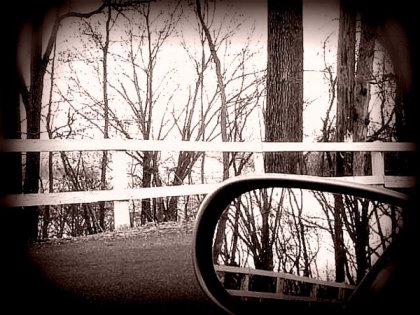 In my youth I struggled with suicidal impulse, particularly after abuse caused me to feel lost, hopeless, and worthless. One afternoon, not long after my 21st birthday, I went walking near my home and staked out the best places to die. This incredibly morbid activity was further fueled by the presence of my camera. The picture you see to the right is one I actually took on that day, albeit after getting back in my car. My feelings of despair had grown so prominent that I wanted to ensure that I’d recall the exact right spot for my next visit.
In my youth I struggled with suicidal impulse, particularly after abuse caused me to feel lost, hopeless, and worthless. One afternoon, not long after my 21st birthday, I went walking near my home and staked out the best places to die. This incredibly morbid activity was further fueled by the presence of my camera. The picture you see to the right is one I actually took on that day, albeit after getting back in my car. My feelings of despair had grown so prominent that I wanted to ensure that I’d recall the exact right spot for my next visit.
Fortunately, by the time I got home I found myself in slightly better spirits and managed to push aside the thoughts of ending my life long enough to regain perspective and start working on some of my negative feelings. The dark time was not obliterated and I spent the next few months trying very, very hard to fight back against the consuming depression that flooded my life.
Certainly I knew there were resources out there, such as therapists and support groups but I eschewed them all because I wanted to cling to my self-image of “toughness” and “independence.” I was convinced that seeking external assistance would render me weak. What I didn’t realize in my stress-addled time was the fact that my toughness and independence were the very tools I needed to survive, but that they had to be channeled through a refining process. This process, of course, was seeking out help. I didn’t do it when I was younger and though I kept thoughts of suicide at bay when depressed, my quality of life deteriorated each time a new episode of difficulty cropped up. I wish I had believed enough in myself to talk to someone much earlier than I did.
For me, the vast majority of my darkness comes from PTSD, from intrusive memories (both physical and mental) that set up bad feedback loops. PTSD is a well-known risk amongst combat veterans and the increasing number of deaths due to suicide in veterans diagnosed with PTSD is heartwrenching. Less understood is PTSD amongst abuse survivors but it’s a very real concern. There are also many, many other reasons that individuals consider suicide but exposure to violence and abuse greatly increase the chance that a survivor will attempt suicide at some point in his or her life. (There’s even a new finding that drug users with histories of child abuse are at an even greater risk of suicidality.) There were 38, 364 suicides reported in the United States in 2010. It is one of the top ten leading causes of death and so often it can be prevented.
We are approaching September 10, which is World Suicide Prevention Day. Advocacy days are largely about creating awareness rather than deep engagement and that’s okay. Awareness breeds action. Taking the time to educate is vital. On the above linked page there are facts, figures, charts, and other informative publications that can be perused. And hop over to Take 5 To Save Lives to see 5 easy things you can do to help stop suicide.
I have encountered the need to use these resources in my advocacy work and the most important piece of advice I can offer is: be willing to listen without judgment when someone tells you he/she is thinking of suicide. It is not uncommon to hear that someone has considered suicide. Don’t panic but also know your own limits and know when to direct someone to other support or to call in other experts. You can use Suicide Hotlines to locate a local resource for someone, or for yourself. There is also the national hotline for the United States. (If you need resources in other countries, those are available as well via this fabulous website.)
 It’s a lot easier to offer perspective on a bad time when you’ve gotten through it so I try very, very hard not to make it seem that I am minimizing others’ struggles. My own were very difficult at times and I do not presume to have the market cornered on difficult experiences. All I know is that I came through my own bleakness with a lot of hard days and with the help of many others who were willing to guide and support me as I grew stronger and less unhappy.
It’s a lot easier to offer perspective on a bad time when you’ve gotten through it so I try very, very hard not to make it seem that I am minimizing others’ struggles. My own were very difficult at times and I do not presume to have the market cornered on difficult experiences. All I know is that I came through my own bleakness with a lot of hard days and with the help of many others who were willing to guide and support me as I grew stronger and less unhappy.
To the left you can see a picture I took years later when I returned to the same general area I visited when I first seriously considered suicide. This time I was enjoying a gorgeous walk in the woods when I discovered that there were stairs. It seems trite to put it into symbolic terms like this but those stairs were my path up to other things, quite literally, and I couldn’t help but think about the difference in thinking, from wanting to hurtle down to wanting to walk up. I don’t for a moment truly regret being alive. I just hope my experiences can help someone else.
Join the World Suicide Prevention Facebook page here. (This page is not affiliated with The Black Window.)